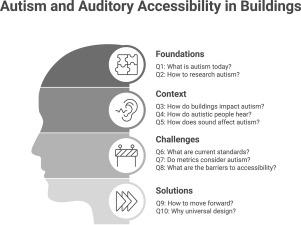Ten questions concerning autism and auditory accessibility in buildings
IF 7.6
1区 工程技术
Q1 CONSTRUCTION & BUILDING TECHNOLOGY
引用次数: 0
Abstract
The ten questions in this paper discuss how the auditory experience of autistic individuals is related to the built environment, integrating perspectives from practitioners and researchers in acoustical engineering, audiology, soundscapes, psychology, architecture, and indoor environment. Autism is a neurodevelopmental disability associated with, as one of its main characteristics, hypo- or hypersensitivity to sensory stimuli. In the built environment, the sensory profile of autistic individuals is directly impacted by thermal, visual, and (the main topic of this paper) acoustical design. However, research on creating more acoustically-inclusive equipment or spaces for this population is still limited, leading to shortcomings in existing acoustic design standards, which do not consider such sensory processing differences. The paper highlights the limitations of current acoustic standards, which are based on neurotypical hearing models, and advocates for inclusive design practices that prioritize the needs of autistic individuals. We also present the shift from a purely medical model to a more nuanced approach that includes discussing ethical research practices, autism as a social concept, appropriate language, and disability rights. Key recommendations include participatory research, flexible acoustic environments, and the adoption of universal design principles to create spaces that accommodate sensory diversity, ensuring both functionality and well-being.

关于自闭症和建筑物听觉无障碍的十个问题
本文的十个问题结合声学工程、听力学、声景、心理学、建筑学和室内环境的实践者和研究人员的观点,讨论了自闭症患者的听觉体验与建筑环境的关系。自闭症是一种神经发育障碍,其主要特征之一是对感官刺激的低敏感性或超敏感性。在建筑环境中,自闭症患者的感官特征直接受到热、视觉和声学设计(本文的主要主题)的影响。然而,为这一人群创造更具声学包容性的设备或空间的研究仍然有限,导致现有声学设计标准存在不足,没有考虑这种感觉加工差异。这篇论文强调了目前基于神经典型听力模型的声学标准的局限性,并倡导优先考虑自闭症患者需求的包容性设计实践。我们还介绍了从纯粹的医学模式到更细致入微的方法的转变,包括讨论伦理研究实践、自闭症作为一个社会概念、适当的语言和残疾人权利。主要建议包括参与性研究,灵活的声学环境,以及采用通用设计原则来创造适应感官多样性的空间,确保功能和福祉。
本文章由计算机程序翻译,如有差异,请以英文原文为准。
求助全文
约1分钟内获得全文
求助全文
来源期刊

Building and Environment
工程技术-工程:环境
CiteScore
12.50
自引率
23.00%
发文量
1130
审稿时长
27 days
期刊介绍:
Building and Environment, an international journal, is dedicated to publishing original research papers, comprehensive review articles, editorials, and short communications in the fields of building science, urban physics, and human interaction with the indoor and outdoor built environment. The journal emphasizes innovative technologies and knowledge verified through measurement and analysis. It covers environmental performance across various spatial scales, from cities and communities to buildings and systems, fostering collaborative, multi-disciplinary research with broader significance.
 求助内容:
求助内容: 应助结果提醒方式:
应助结果提醒方式:


